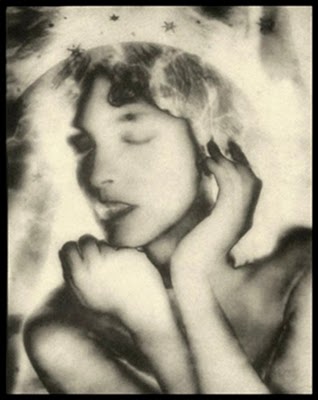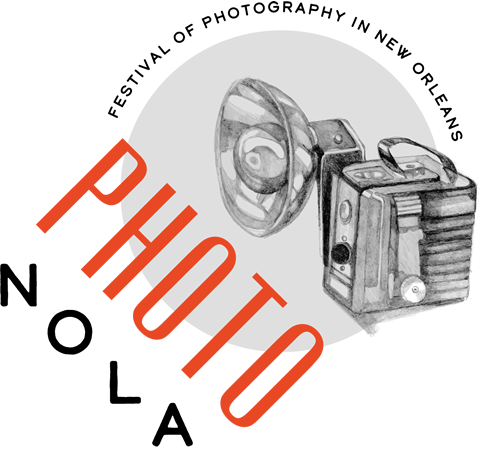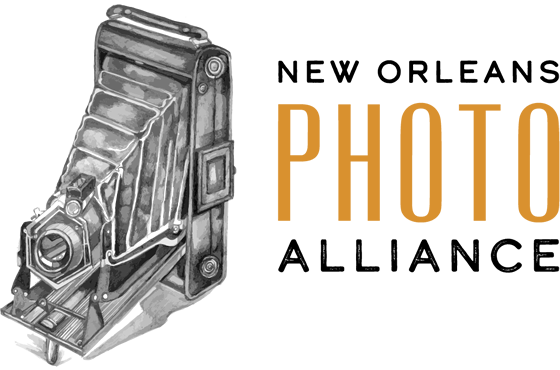Eric Bookhardt, art critic for Gambit Weekly, reviews REVIVAL at Homespace Gallery and John T. Mendes: Dogs in My Life at The Historic New Orleans Collection.
Revival, a group show, and Dogs In My Life by John T. Mendes
 Once, photographs were made with big, bulky cameras that used glass negatives. By the early 20th century they were rarely ever used, but a notable exception was John T. Mendes, who documented New Orleans from 1916 through the 1920s. A keen observer who loved dogs (the title was taken from a memoir he wrote), Mendes melded a pro’s techniques with a childlike sense of whimsy as we see in FEMALE IMPERSONATOR, 1919, a year Carnival was canceled but the drag queens came out anyway, or MISS LUCILLE NEWLIN AND MAYOR BEHRMAN WELCOME REX AT CITY HALL, FEBRUARY 1917, below. Aviators, dog circuses, floods, Mardi Gras and children’s parades are among the subjects that inhabit this charming view of the city, a refreshing survey from a local original who was totally unknown until these glass plate negatives were discovered in an Uptown attic. A striking 120 page catalog, published by the UNO Press, is also available.
Once, photographs were made with big, bulky cameras that used glass negatives. By the early 20th century they were rarely ever used, but a notable exception was John T. Mendes, who documented New Orleans from 1916 through the 1920s. A keen observer who loved dogs (the title was taken from a memoir he wrote), Mendes melded a pro’s techniques with a childlike sense of whimsy as we see in FEMALE IMPERSONATOR, 1919, a year Carnival was canceled but the drag queens came out anyway, or MISS LUCILLE NEWLIN AND MAYOR BEHRMAN WELCOME REX AT CITY HALL, FEBRUARY 1917, below. Aviators, dog circuses, floods, Mardi Gras and children’s parades are among the subjects that inhabit this charming view of the city, a refreshing survey from a local original who was totally unknown until these glass plate negatives were discovered in an Uptown attic. A striking 120 page catalog, published by the UNO Press, is also available.
Today, even as digital photography has made film cameras almost obsolete, there is new interest in even older, more archaic techniques. REVIVAL at the Homespace Gallery features tintypes, daguerreotypes, photogravures, cyanotypes and other 19th century processes employed by talented contemporary photographers. In their hands, the act of image making is transformed from a routine pastime to something far more poetic. Ordinary things like the thistle in a glass in Kevin Kline’s tintype, or the close-up of the extruded velvety innards of a magnolia flower in David Halliday’s Van Dyke print, are revealed in a fresh new light. One of the more dramatic images is Josephine Sacabo’s photogravure SLEEP WALKER, top. Photogravure is a complicated process that melds intaglio printing and photography, but some far less complicated yet no less dramatic images were made by some Louise S. McGehee School students, who used the old cyanotype process in playful new ways, for instance, FANTASMA by Sarah Miller, below. Curated by the Ogden Museum’s Richard McCabe, REVIVAL suggests that some traditional photographic processes don’t just get old, they sometimes–in the right hands–get better. ~Bookhardt
The original Gambit Weekly posting is here: bestofneworleans.com/gyrobase/Content?oid=oid%3A67419
Bookhardt’s Inside Art New Orleans posting, featuring additional images can be seen here: www.insidenola.org/2010/01/revival-at-homespace-mendes-at-hnoc.html

